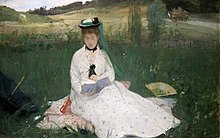Impressionism was a 19th-century art movement that originated with a group of Paris-based artists whose independent exhibitions brought them to prominence during the 1870s and 1880s in spite of harsh opposition from the art community in France. The name of the style is derived from the title of a Claude Monet work, Impression, soleil levant (Impression, Sunrise), which provoked the critic Louis Leroy to coin the term in a satiric review published in the Parisian newspaper Le Charivari.
Characteristics of Impressionist paintings include relatively small, thin, yet visible brush strokes; open composition; emphasis on accurate depiction of light in its changing qualities (often accentuating the effects of the passage of time); common, ordinary subject matter; the inclusion of movement as a crucial element of human perception and experience; and unusual visual angles. The development of Impressionism in the visual arts was soon followed by analogous styles in other media which became known as Impressionist music andImpressionist literature.
Radicals in their time, early Impressionists violated the rules of academic painting. They began by constructing their pictures from freely brushed colours that took precedence over lines and contours, following the example of painters such as Eugène Delacroix and J. M. W. Turner. They also painted realistic scenes of modern life, and often painted outdoors. Previously, still lifes and portraits as well as landscapeshad usually been painted in the studio. The Impressionists found that they could capture the momentary and transient effects of sunlight by painting en plein air. They portrayed overall visual effects instead of details, and used short "broken" brush strokes of mixed and pure unmixed colour—not blended smoothly or shaded, as was customary—in order to achieve the effect of intense colour vibration.
Although the emergence of Impressionism in France happened at a time when a number of other painters, including the Italian artists known as the Macchiaioli, and Winslow Homer in the United States, were also exploring plein-air painting, the Impressionists developed new techniques that were specific to the style. Encompassing what its adherents argued was a different way of seeing, it was an art of immediacy and movement, of candid poses and compositions, of the play of light expressed in a bright and varied use of colour.
The public, at first hostile, gradually came to believe that the Impressionists had captured a fresh and original vision, even if the new style did not receive the approval of the art critics and establishment.
By recreating the sensation in the eye that views the subject, rather than delineating the details of the subject, and by creating a welter of techniques and forms, Impressionism became a precursor of various styles of painting, including Neo-Impressionism, Post-Impressionism, Fauvism, and Cubism.



Prior to the Impressionists, other painters, notably such 17th-century Dutch painters as Jan Steen, had emphasized common subjects, but their methods of composition were traditional. They arranged their compositions in such a way that the main subject commanded the viewer's attention. The Impressionists relaxed the boundary between subject and background so that the effect of an Impressionist painting often resembles a snapshot, a part of a larger reality captured as if by chance.
Hiç yorum yok:
Yorum Gönder